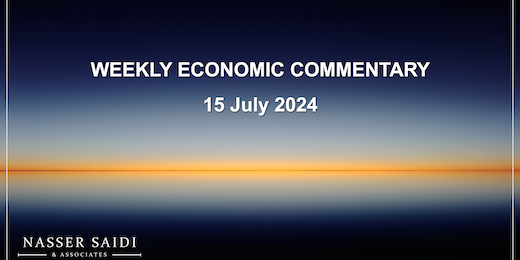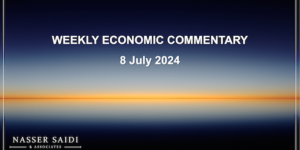Download a PDF copy of the weekly economic commentary here.
Markets
Bets for an interest rate cut from the Fed rose after the inflation print for Jun eased: this led to upticks in global equities markets despite underperforming earnings results till date and the MSCI global index grew by 1.3% from the week before. Regional markets were mostly higher on potential Fed cuts. The GBP strengthened last week post-elections, clocking the highest in almost a year given the GDP data and comments from the BoE (lowering expectations for a rate cut come August). While oil prices fell last week, gold price was up for the third week in a row on rate cut expectations.

Global Developments
US/Americas:
- Inflation in the US eased to 3% in Jun (May: 3.3%) while excluding food and energy, prices slipped to 3.3% (May: 3.4%). In month-on-month terms, prices edged down by 0.1%, falling for the first time since 2020, largely due to lower petrol prices and moderation in rental costs.
- Producer price index in the US ticked up to 2.6% yoy in Jun (May: 2.4%), the largest yoy uptick since Mar 2023. The 0.6% rise in services costs accounted for the increase in PPI while excluding foods, energy and trade, prices were up 3.1% (lower than May’s 3.3%).
- US budget deficit stood at USD 66bn in Jun, reduced from May’s deficit of USD 347bn, partly due to calendar effects. Receipts increased by 11% yoy to USD 466bn while spending fell by 18% to USD 532bn. In the first 9 months of the 2024 fiscal year, deficit narrowed to USD 1.268trn (-9% yoy).
- NFIB business optimism index in the US improved to 91.5 in Jun (May: 90.5), the highest this year but below the long-term average of 97.9.
- Michigan consumer sentiment index edged down to an 8-month low of 66 in Jul (Jun: 68.2), owing to a dip in both the current conditions (64.1 in Jul from 65.9 in Jun) and expectations (67.2 from 69.6) sub-indices. The one and five-year inflation expectations eased to 2.9% (from Jun’s 3% reading).
- Initial jobless claims decreased sharply by 17k to 222k in the week ended Jul 5, the lowest level since May, taking the 4-week average falling by 5.25k to 233.5k. Continuing jobless claims fell by 4k to 852mn in the week ended Jun 28th.
Europe:
- Sentix investor confidence in the eurozone slipped to -7.3 in Jul (Jun: 0.3) as. The expectations index dropped to 1.5 (Jun: 10) and the current situation fell to -32.3 (Jun: -26.3).
- German exports declined by 3.6% mom in May and imports declined by a faster 6.6%, resulting in a wider surplus of EUR 24.9bn. Exports to other EU nations dropped by 2.5% while exports to the US, China and Russia fell by 2.9%, 10.2% and 19.3% respectively.
- Wholesale price index in Germany dropped by 0.3% mom and 0.6% yoy in Jun (May: 0.1% mom and -0.7% yoy). In yoy terms, prices were down for the 14th month in a row.
- UK GDP grew by 0.4% mom in May, after recording zero growth in Apr. Construction grew at the fastest pace in almost a year, while industrial production and manufacturing grew by 0.4% yoy and 0.6% respectively. In the 3 months to May, the UK economy grew by 0.9%.
- BRC like-for-like retail sales in the UK fell by 0.5% yoy in Jun, reversing May’s 0.4% gain. Non-food sales fell by 2.9% yoy in Apr-Jun (prev: -2.4%) while food sales fell to 1.1%.
Asia Pacific:
- GDP in China grew by 4.7% in Q2, the slowest since Q1 2023 and below the previous quarter’s 5.3% rise, likely affected by the housing/real estate continuing downturn.
- China’s inflation eased to 0.2% yoy in Jun (May: 0.3%) as food prices continued to fall (-2.1% from May’s -2%) while non-food inflation remained broadly stable (at 0.8%). Core inflation increased by 0.6% yoy, mirroring May’s reading.Producer price index fell by 0.8% yoy in Jun (May: -1.4%), staying negative for the 21st month in a row. Prices fell 2.1% in H1.
- Exports from China accelerated by 8.6% yoy in Jun (May: 7.6%) – the fastest pace in 15 months – while imports fell by 2.3% (May: +1.8%), taking the surplus to a wider USD 99.05bn (the highest on record since 1981). The exports likely reflect front-loaded orders in anticipation of the implementation of increased tariffs across US, EU, Turkey and Indonesia among others.
- New home prices in China fell by 3.9% yoy in May, the steepest decline in nine years, after falling for 11 months in a row. Property investment fell by 10.1% in H1 2024 and home sales by floor area declined by 19%.
- Money supply (M2) in China increased by 6.2% yoy in Jun (May: 7%). New loans surged to CNY 2.13trn in Jun, more than double May’s disbursement (CNY 950bn), taking the total to CNY 13.27trn in H1 2024. Household loans jumped to CNY 570.9bn (May: CNY 75.7bn) and corporate loans stood at CNY 1.63trn (May: CNY 740bn). Annual growth of outstanding total social financing (TSF) slowed to 8.1% in Jun (May: 8.4%).
- Industrial production in Japan rebounded by 3.6% mom in May (prelim: 2.8% and Apr: -0.9%); IP was also up by 1.1% yoy, expanding for the first time in 7 months. Output of motor vehicles supported the recovery (18.1% mom from Apr’s 0.6% dip) as did electrical machinery, information & communication electronics equipment (5.3% from 2.4% drop).
- Japan’s producer price index inched up by 0.2% mom and 2.9% yoy in Jun (May: 0.7% mom and 2.6% yoy). This yoy increase was the most since Aug 2023, partly as the government reduced energy subsidies. Import and export prices were up by 9.5% and 10.4% respectively.
- Machine tool orders in Japan rose for the second month in Jun, up by 9.7% yoy (May: 4.2%), led by a surge in foreign orders (+14.6%) as domestic orders fell by 0.1%.
- South Korea’s central bank left interest rates unchanged for the 18th consecutive month. While the BoK governor signalled a rate cut, he highlighted that there was a need to “monitor the foreign exchange market, rising housing prices and household debt growth”
- Inflation in India edged up to 5.08% yoy in Jun (May: 4.8%), remaining within the RBI’s target range (of 2-6%) for the 10th month in a row. Food prices increased (9.4% from May’s 8.7%) as did housing (2.7% from 2.6%).
- India’s industrial output grew by 5.9% yoy in May (Apr: 5%), the fastest pace since Oct 2023, with gains recorded in electricity generation (13.7%) and consumer durables production (12.3%) while manufacturing grew by just 4.6% (though faster than Apr’s 3.9% gain).
- Q2 GDP expanded by 0.4% qoq and 2.9% yoy in Singapore (Q1: 0.3% qoq and 3% yoy), supported by gains in construction (4.3% yoy, mostly public sector construction output) and services while manufacturing rebounded (0.5% yoy from Q1’s 1.7% drop).
- Pakistan and IMF reach a USD 7bn medium-term financing deal, the country’s 24th bailout with the IMF.
Bottom line: The shooting attempt on former US President Trump is likely to boost to his re-election efforts (markets are pricing in a rising probability of a second term), but markets are expected to focus on immediate economic data releases (such as US retail sales). Separately, while the Fed officials have signalled rate cuts (supported by an easing of inflation and a cooling labour market), the ECB will likely hold pat on rates (especially given the pickup in wage growth). The latest spate of Chinese macro data disappointed (from GDP to property investment) – making the Communist Party’s “Third Plenum” this week (starting today) important with respect to reforms announcements.
Regional Developments
- Egypt’s annual urban inflation slipped to 27.5% in Jun (May: 28.15%), the lowest reading since Jan 2023 and slowing for the 4th month in a row. Food and beverage costs increased by 30.8% yoy and by 3% mom while core inflation eased (to 26.6% yoy from 27.1%).
- Egypt’s net international reserves grew to a record high of USD 46.4bn in June, supported by the rise in foreign currency reserves (+37.9% ytd to USD 36.9bn). This will support repayment of external debt and interest payments while also providing essential import cover. Additionally, gold reserves were up 12.4% this year to USD 9.5bn.
- The IMF rescheduled this week’s executive board meeting for Egypt to Jul 29th, though no reason was given. An official source disclosed that the recent cabinet reshuffle (including change in the minister of finance) was a reason for the delay, avoiding burdening a new government with unpopular reforms. It is possible that reforms could be pushed through during this time (e.g. subsidy reform), resulting in a more positive evaluation. When this review is completed, another USD 820mn will be provided by the IMF.
- Egypt’s new government’s three-year plan (2024-25 to 2026-27) aims to grow the economy by 4.2%, according to the PM. Furthermore, it targets (a) doubling the contribution of the green economy investment to total public investments (to about 55%) in 2026; (b) increasing private investments to 60-65% of total investment; (c) raising FDI growth rate to about 14% by 2030; (d) growing exports by more than 15% annually; and (e) attracting 30 million tourists by 2028.
- Remittances into Egypt surged by 26.6% mom and 73.8% yoy to USD 2.7bn in May, according to the central bank. In 2022-23, remittances declined by 30.8% yoy to USD 22.1bn.
- Egypt’s balance of payments surplus widened to USD 4.1bn in Jul-Dec 2023, thanks to a jump in net inflow into the capital and financial account (USD 20bn from USD 8.1bn in the same period a year ago) – in turn driven by upticks in FDI (USD 23.7bn from USD 7.9bn) and portfolio investment inflows (at USD 14.6bn). However, the current account deficit widened to USD 17.1bn (from USD 5.3bn), as remittances fell, and trade deficit widened over Jul-Dec 2023.
- Mobile wallet transactions in Egypt surged by 112% yoy to EGP 1.3trn in 2023, as number of mobile wallet accounts rose (30% to 39.4mn) per central bank data.
- Digital exports from Egypt increased to USD 6.2bn in 2022-23 from USD 4.9bn the previous year. The added value of Egypt’s IT sector increased by 31.5% yoy to EGP 275.5bn during the year, supported by the nation’s young and skilled workforce as well as its supportive infrastructure, according to the report on the outsourcing industry.
- Egypt approved five crude oil and gas agreements with foreign and domestic energy companies with expected investments of about USD 200mn; this includes gas and crude oil exploration projects in the Mediterranean, Nile delta and Western desert.
- Indian investments in Egypt total about USD 3.7bn, disclosed the Indian Ambassador to Cairo, while Egyptian investments in India amount to around USD 37mn.
- Iraq revealed plans to attract investment from Egypt and Saudi Arabia in five new cities, as part of the government’s initiative to launch 11 new cities (hence addressing housing shortages especially for low-income groups).
- Kuwait discovered “huge commercial quantities” of oil and gas: estimates suggest that the discovery could yield about 2.1bn barrels of light oil and 5.1trn standard cubic feet of gas, which corresponds to approximately 3.2bn barrels of oil equivalent.
- Oman’s budget surplus clocked in at OMR 351mnas of end-May, narrowing from a surplus of OMR 581mn as of May 2023, as both revenues and spending declined. Public revenues fell by 7.1% yoy to OMR 5.075bn as of May 2024: net oil revenues dropped by 2.5% to OMR 2.7bn net gas revenues fell by 23.9% to OMR 763mn. Expenditure declined by 3.2% yoy to OMR 4.724bn at end-May, with current expenditure edging slightly lower (-0.7% yoy to OMR 3.34bn).
- Assets of Islamic banks in Oman rose by 13.2% yoy to OMR 7.5bn (USD 19.5bn) at end-Apr, equivalent to 17.7% of total banking sector capital. Financing extended by these banks increased by 12% to OMR 6.3bn.
- Qatar’s foreign reserves grew by 3.88% yoy to QAR 250.091bn as of Jun 2024, according to the central bank. Gold reserves increased by QAR 8.1bn to QAR 28.977bn.
- Population in Qatar stood at 2.85mn as of end-Jun: this is up 85.4% from 1.54mn recorded at end-Oct 2008. Males accounted for 72.4% of total population and the share of 15-24 and 25-64-years age groups in total population stood at 11.1% and 73.2% respectively.
- Passenger traffic into Qatar’s international airport grew by 16.4% yoy to 4.34mn in Jun. Air cargo grew by 10.1% yoy to 214,823 tons during the same period.
- Real estate trading volume in Qatar fell by 11.9% yoy to QAR 1.11bn (USD 302mn) in Jun, with transactions also declined by 11.49% to 285.
- A GCC-UK free trade agreement could be signed by end-2024, revealed the GCC Secretary General following a meeting with UK Trade Minister.
- According to MAGNiTT, investors in the MENA VC ecosystem surged by 33% in H1 2024, alongside a 130% jump in the number of funds. Funding fell by 34% yoy to USD 768mn while the number of deals fell by 18% to 211. Saudi Arabia secured USD 412mn in funding. In H1 2023, while e-commerce was the sector with most funding (USD 244mn) and fintech dominated in terms of deal count.
- Wamda data indicated that 38 tech startups in MENA raised USD 116mn (up 182% yoy, but fell by 59% mom) in Jun, totalling investment activity to USD 882mn in H1 2024. UAE startups secured USD 82.5bn across 15 deals, followed by Egypt’s 4 firms raising USD 15mn.
- An Indian newspaper (Mint) reported that two sovereign wealth funds from the GCC (Abu Dhabi Investment Authority & Kuwait Investment Authority) and Singapore’s GIC Holdings invested INR 5trn (USD 60bn) in Indian stock markets and startups as of Mar 2024. The GIC holds as much as INR 2.5trn in Indian stocks alongside KIA and Norway’s Norges Bank’s investment of more than INR 1.5trn in the stock market.
- Contracts awarded in the GCC declined by 19.7% yoy to USD 51.7bn in Q2 2024, dragged down by Qatar (-98.5% to USD 162mn) and the UAE (-62.9% to USD 4.4bn). Saudi Arabia and UAE were the top markets in the region.
Saudi Arabia Focus
- Saudi Arabia raised USD 12.35bn from the secondary share sale in Aramco, after increasing the offering, reported Reuters. Separately, Aramco drew USD 31.5bn in orders for its three-part bond sale for USD 6bn.
- Industrial production in Saudi Arabia declined by 2.9% yoy in May, as oil activities fell by 8.4%. Although IP dropped for the 13th consecutive month in yoy terms, it grew by 1.4% compared to Apr. Overall manufacturing inched up by 1.4% mom and 13.9% yoy while non-oil activities grew by 12.8% yoy.
- The Ministry of Commerce in Saudi Arbia reported a 76% yoy jump in logistics services sector registrations in Q2 2024; the AI sector grew by 53% clocking in 8948 registrations.
- Remittances from Saudi Arabia grew by 11% mom and 12% yoy to SAR 12.6bn (USD 3.4bn) in May, the highest level in nearly 2 years.
- Saudi Arabia ranked second-highest in the world for average daily time spent playing video games, according to US-based online gaming platform Mobile Premier League.
- The CMA permitted listed firms to split stock par values from SAR 10 to lower options starting end Jan 2023. Stock splits benefited 42 companies in 2023 – 18 in Tadawul (8% of listed firms) and 24 in Nomu.
- Credit facilities provided to micro, small, and medium enterprises in Saudi Arabia grew by 16% yoy to SAR 293.43bn (USD 78.25bn) in Q1 2024. Medium enterprises received the lion’s share of the credit (SAR 160.6bn) while credit to small companies posted the highest growth (32% to SAR 103.5bn).
- Saudi Arabia expanded access to its local bond markets by appointing five more financial institutions – Albilad Investment Co., AlJazira Capital Co., Al Rajhi Capital Co., Derayah Financial Co., and Saudi Fransi Capital Co. – as primary distributors of government debt instruments, thereby diversifying the investor base.
- Point-of-sale spending in Saudi Arabia increased by 7.7% to SAR 13.2bn (USD 3.51bn) in the week ending July 6, with the largest increase comping from hotel payments (17.9% to SAR 259.7mn) while spending on food and beverages had the largest share (+8.8% to SAR 2.05bn).
UAE Focus
- UAE’s gross bank assets grew by 1% mom and 13% year-to-date (ytd) to AED 4.296trn as of end-Apr. Money supply (M2) inched up by 0.6% mom to AED 2.148trn, domestic credit increased by 0.8% mom and 8.8% ytd to AED 2.06trn while bank deposits were up 15.6% ytd to AED 2.72 trn. The balance sheet of the UAE central bank expandedby 25% yoy and 9.6% ytd to a record high AED 789.82bn in Apr.
- Non-oil GDP in Abu Dhabi surged to contribute 54% to GDP last year (vs 46% in 2011) while high-skilled talents grew by 109% and foreign investments were up by 300%, disclosed the Chairman of Abu Dhabi Department of Economic Development.
- The government of Sharjah initiated the sale of EUR 500mn (USD 541mn) 6.5-year sustainable bond, its second green bond issuance this year, with plans to use the proceeds to finance and refinance “eligible expenditures” under its Sovereign Sustainable Financing Framework.
- The Department of Economic Development in Ajman revealed that business activity grew in H1 2024, with a total of 3000 new licenses issued (+5%) and active licenses up by 15% yoy to 37,755.
- A report from Knight Frank showed a slight decline in high-end property sales in Dubai in H1 2024: 190 homes valued at USD 3.2bn were sold during the year (vs 189 homes for USD 3.3bn). There was a 65.5% drop in the number of luxury homes on the market, as buyers were purchasing for personal use than to flip for higher rates.
- Etihad Airways logged a nearly 40% yoy jump in passenger traffic to 8.7mn in H1 2024, with the 12-month total till Jun 2024 standing at 16.4mn, according to the CEO. The number of destinations rose to 76 (from 66 in Jun 2023) and aircraft grew to 92 (from 76).
Media Review:
Emerging Markets Show Resilience Despite Global Monetary Tightening
https://www.imf.org/en/Blogs/Articles/2024/07/12/emerging-markets-show-resilience-despite-global-monetary-tightening
Bracing for a More Inflationary World
https://www.project-syndicate.org/commentary/inflationary-pressures-from-aging-deglobalization-climate-and-immigration-policies-by-raghuram-g-rajan-2024-07
The messy truth about achieving economic growth
https://www.ft.com/content/f08e2a66-b2ee-4def-b6b2-315260905a89
Powered by:







